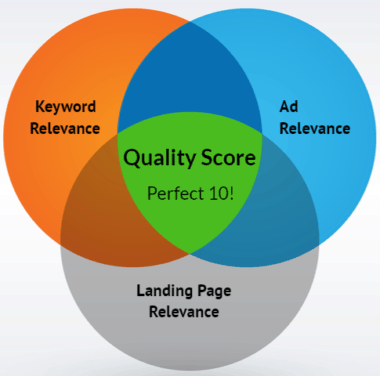If you use PPC as part of your digital marketing efforts, you’re probably familiar with the term Quality Score.
It’s an indication of the quality of your keywords, ads, and landing pages, helping you understand how competitive your ads are in the marketplace.
Based on a score of 1-10, with 10 being the very best, the score is available as a column in either your Bing Ads (the company I work for) or Google Ads UIs.
It’s intended to inform your advertising strategy, helping your ads become more searchable and dollars go farther.
But Does Quality Score Really Matter Anymore?
It’s pretty easy to ignore, especially if you believe there’s nothing you can do to improve your ranking.
But I’m here to tell you, the numbers matter, and your quality score is still a very important diagnostic tool in your search toolkit.
OK, it isn’t the “end-all” that tells you if you should or should not be advertising on a keyword.
However, it lets you know if something isn’t working the way you expected it to and how to fix it.
Here’s why your quality score still matters.
Quality Score Is a Calculation of Ad Relevance
Quality score is essentially a calculation to explain the relevance of your keywords to the search queries, your keywords to your ad copy, your keywords to the landing page, and then the landing page to the ad copy.
Picture a Venn Diagram trifecta of relevance, and when all three of these components overlap, that is a number 10 quality score, and it’s perfect.

That means your keyword is related to the landing page, it’s related to the search query, and the search query is related to the ad copy.
It’s a beautiful thing!
It Helps Determine How Much You Pay
Your quality score times your CPC equals a number, and it’s used to decide who ranks where within the search auction, and that dictates how much your overall spend is going to be.
For example, if you have a quality score of 1 and another advertiser has a quality score of 10, you will have to pay 10 times more to outrank your competitor’s keyword.
If you bid $1 with a quality score of 1, your competitor with a score of 10 would only have to pay $0.10 to outbid you.
As you can see, it’s much more expensive to you as an advertiser for lower quality score keywords. But that doesn’t mean those keywords aren’t potentially important to your business.
It means that you have the opportunity to improve the relevance and lower your cost through your ad copy, your landing pages, or your query to keyword mapping.
How to Optimize for Quality Score
When we think about quality score, there are three components that it measures, and as you optimize these three components, searchable magic happens.
Here are a few areas you can focus on to improve that stubborn quality score.
Expected Click-Through Rate (CTR)
Your expected click-through rate and ad relevance tell you if the rate you receive for that keyword above or below average. If it’s below average, take a look at your ad text.
The expected CTR is all about ad creativity that inspires action and results on the page.
Think about how to highlight a unique benefit of your product or service, or experiment with different calls to action.
Try being more specific in your ad text and making sure that the search query is relevant to that keyword so that it’s showing up in that ad copy.
Understand the difference between search terms and the queries people use to search (i.e., the formal term of pacifier vs. other ways people may search for these words like binky, binkie and paci).
Bidding on your competitor’s brand terms and phrases (a.k.a. conquesting) can add to a lower expected CTR as well.
For example, if you’re selling Nike shoes and somebody’s searching for Adidas, you shouldn’t have Adidas in your ad copy unless you have Adidas products for sale. (There are policies for conquesting and using trademarks as part of the editorial guidelines.)
Ad Relevance
This goes back to the relevance of your keywords to the search queries, the keywords to your ad copy. If your ad relevance score is low, there are a few key ways to improve it:
- Move keywords to smaller ad groups and be much more targeted with the ad creative toward those specific keywords.
- Look for ad groups with disparate keywords that really couldn’t be addressed by the same ad. For example, if I’m a shoe company, I would need to have separate ad groups for Nike shoes versus Adidas shoes. And similarly, I’d want to have different ads for tennis shoes versus high heels, because it’s going to give you lower ad relevance if somebody’s searching for Nike track spikes and Nike tennis shoes or Nike soccer cleats pop up.
- Add negative keywords to prevent your ads from showing on irrelevant queries. For example, a stock trading company would want to add “soup stock” as a negative keyword, because if their keywords match to that result, their ad relevance will plummet. (True story. I discovered this in a PPC audit where a stock trading company spent $10K’s on soup stock!)
- Speak to the intent embedded in a user’s query. If the user is asking about pricing, for example, putting pricing in the ad copy (or in some element of the extension or promotion) will boost your relevance.
- Match the language of the text to be similar to that user’s search query.
Landing Page Relevance
In short, you need to have a good landing page and be mindful of what you link to in the ad copy.
Consumers expect that when they click on an ad that says, “Get a pair of Nike shoes, $29.99,” that they will see Nike shoes for $29.99 on that page. And if they don’t, your score is going to head south.
Here are a couple suggestions to boost this score:
- Send traffic to landing pages that are closely related to the user’s query or the keyword.
- Don’t send everyone to the homepage.
- Send users to the right stage of the funnel and to the right content or product specific information.
- Make sure the landing page continues the conversation you’ve set up with the ad. If you’re promoting a deal in the ad, that deal needs to be highly visible on the landing page too.
- Make sure all the buttons work and next steps are apparent.
- Use the conversion rate as a proxy that tells you if users consider that page relevant. Are they taking action and doing what you want them to do?
- Look at your bounce rate. If it’s high, you may be sending traffic to wrong page or there’s a disconnect between the user’s intent and the content.
- Make sure you have a mobile-optimized site and people are being sent to it when they’re on a handheld device.
- Evaluate your page load speed. Lower speeds will impact your quality score as users bounce before the content is visible. We are an impatient bunch!
Conclusion
Quality score is a Swiss army knife in your diagnostic toolkit that helps you uncover what might be going on – on your site, with your ad copy or with your keywords, to make your accounts perform better.
There are no shortcuts to a better quality score – it takes hard work. But honestly, a little change can go a long way to boost your rank and make search work for you.
More Paid Search Resources:


